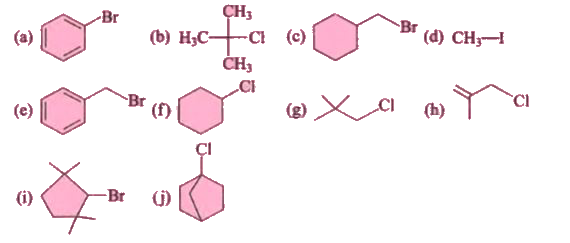Bromoethane on treatment with alcoholic KOH gives
ethyl alcohol
butane
methane
ethylene
The correct Answer is:D
To solve the question regarding the reaction of bromoethane with alcoholic KOH, we can follow these steps:
Step 1: Identify the Reactants
The reactant in this case is bromoethane (C2H5Br) and the reagent is alcoholic KOH.
Step 2: Understand the Reaction Type
Alcoholic KOH is known to act as a dehydrohalogenating agent. This means it will facilitate the elimination of hydrogen and bromine from bromoethane.
Step 3: Elimination of HBr
In the reaction, a hydrogen atom (H) from one carbon and the bromine atom (Br) from the adjacent carbon are eliminated. This results in the formation of HBr as a byproduct.
Step 4: Formation of Ethene
The elimination of H and Br leads to the formation of a double bond between the two carbon atoms, resulting in the formation of ethene (C2H4).
Step 5: Write the Balanced Equation
The balanced equation for the reaction can be written as:
C2H5Br+KOH (alc)→C2H4+KBr+H2O
Conclusion
Thus, the product of the reaction of bromoethane with alcoholic KOH is ethene.
---
The reactant in this case is bromoethane (C2H5Br) and the reagent is alcoholic KOH.
Alcoholic KOH is known to act as a dehydrohalogenating agent. This means it will facilitate the elimination of hydrogen and bromine from bromoethane.
In the reaction, a hydrogen atom (H) from one carbon and the bromine atom (Br) from the adjacent carbon are eliminated. This results in the formation of HBr as a byproduct.
The elimination of H and Br leads to the formation of a double bond between the two carbon atoms, resulting in the formation of ethene (C2H4).
The balanced equation for the reaction can be written as:
C2H5Br+KOH (alc)→C2H4+KBr+H2O
Thus, the product of the reaction of bromoethane with alcoholic KOH is ethene.
Topper's Solved these Questions
- HYDROCARBONS BOOK - ICSECHAPTER - HYDROCARBONS EXERCISE - TRUE OR FALSE TYPE QUESTIONS
35 Videos
- HYDROCARBONS BOOK - ICSECHAPTER - HYDROCARBONS EXERCISE - FILL IN THE BLANKS TYPE QUESTIONS
22 Videos
- HYDROCARBONS BOOK - ICSECHAPTER - HYDROCARBONS EXERCISE - ESSAY (LONG ANSWER) TYPE QUESTIONS
28 Videos
- EQUILIBRIUM BOOK - ICSECHAPTER - EQUILIBRIUM EXERCISE - NCERT TEXT-BOOK EXERCISE
109 Videos
- HYDROGENBOOK - ICSECHAPTER - HYDROGENEXERCISE - NCERT TEXT-BOOK EXERCISE (With Hints and Solutions)
53 Videos
Similar Questions
Knowledge Check
A mixture of 1−chloropropane and 2−chloropropane when treated with alcoholic KOH, it gives
Aprop-1-eneBprop-2-eneCa mixture of prop-1-ene and prop-2 eneDpropanol.Trans-2-phenyl-1-bromocyclopentane on reaction with alcoholic KOH produces
A4-phenylcyclopenteneB2-phenylcyclopenteneC1-phenylcyclopenteneD3-phenylcyclopentene
Examine the ten structures shown below and select those that satisfy each of the following condition.

How many compounds give E2 reaction on treatment with alcoholic KOH?
View SolutionGem dihalides on treatment with alcoholic KOH followed by action of NaNH2 gives:
View SolutionRewrite each incorrect statement in the correct form using appropriate word/words.
Bromoethane reacts with alcoholic KOH to liberate ethene by dehalogenation.
View SolutionWhat happens when 2-bromopropane is treated with alcoholic KOH
View SolutionAn organic compound (A) C4H9Cl on reacting with aqueous KOH gives (B) and on reaction with alcoholic KOH gives (C ), which is also formed on passing the vapours of (B) over the heated copper. The compound (C ) readily decolourises bromine water. Ozonolysis of (C ) gives two compounds (D) and (E ). Compound (D) reacts with NH2OH to give (F) and compound (E ) reacts with NaOH to have an alcohol (G) and sodium salt (H) of an acid. (D) can also be prepared form propyne on treatment with water in the presence of Hg2+ and H2SO4. Identify (A) to (H) with proper reasoning.
View SolutionA compound A with molecular formula C15H13Cl gives a white precipitate on adding silver nitrate solution A on reacting with alcoholic KOH gives compound B as the main product. B on ozonolysis gives C and C gives Cannizaro reaction but not aldol condensation. D gives aldol condensation but not Cannizaro react A is :
View Solution
